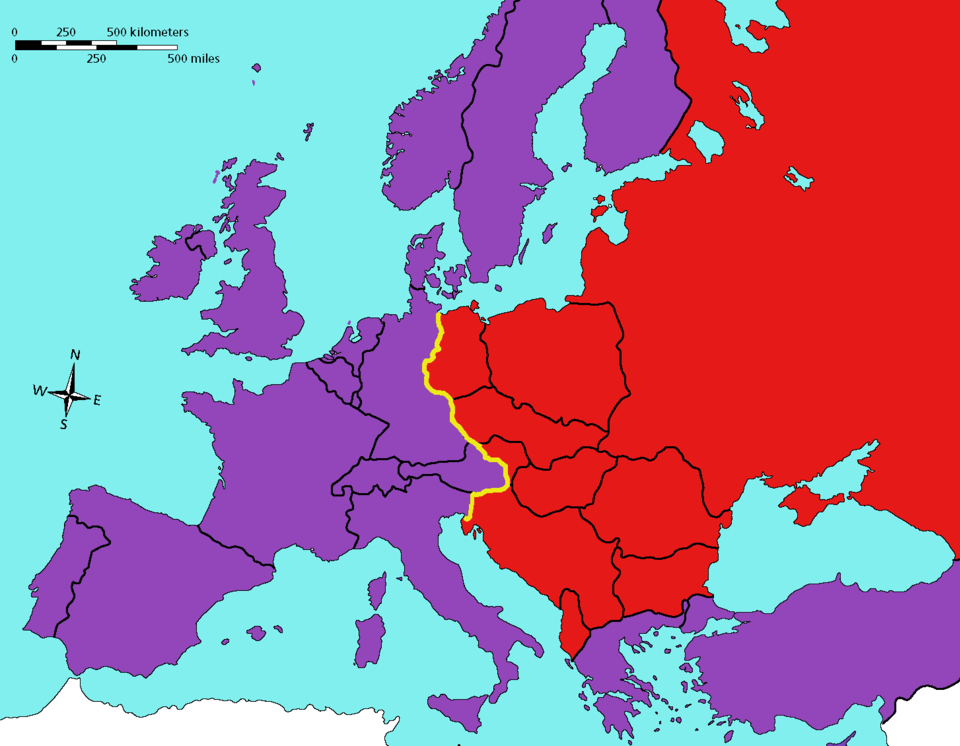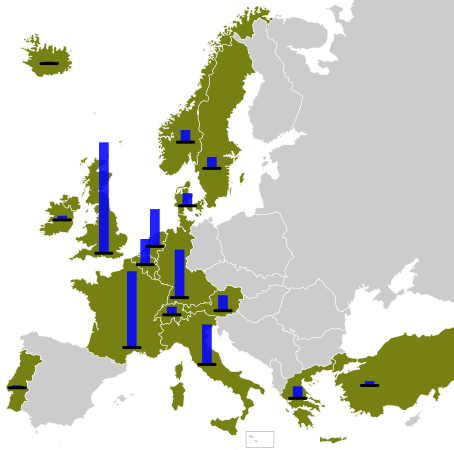OCR Specification focus:
‘Iron Curtain’ speech; Soviet control of Eastern Europe: including Baltic States, Poland, Hungary, Czechoslovakia, Romania, Greece, Yugoslavia; the Truman Doctrine and Marshall Aid
The post-war landscape of Europe witnessed escalating East–West tensions. Winston Churchill’s ‘Iron Curtain’ speech (1946) and Soviet consolidation of Eastern Europe shaped the ideological and geopolitical struggle that defined the Cold War.
Churchill’s ‘Iron Curtain’ Speech
In March 1946, Winston Churchill delivered a speech in Fulton, Missouri, declaring that an “Iron Curtain” had descended across Europe.
The phrase symbolised the division between capitalist Western Europe and communist Eastern Europe.

This schematic map traces the “Iron Curtain” line from Szczecin (Stettin) to Trieste, reflecting Churchill’s wording in 1946. It highlights the conceptual boundary between Western and Eastern Europe without adding military alliance overlays. Source
Key points of the speech
Asserted that Soviet influence had extended into Eastern Europe, creating spheres of control.
Warned of the dangers of unchecked Soviet expansionism.
Advocated Anglo-American cooperation as a counterbalance.
Viewed by Moscow as provocative, worsening relations.
Iron Curtain: A symbolic and physical division separating Soviet-controlled Eastern Europe from the democratic capitalist states of Western Europe after the Second World War.
Churchill’s address reflected growing Western concerns but also hardened Stalin’s perception of Western hostility. It became a defining moment in the early Cold War narrative.
Soviet Control of Eastern Europe
Between 1945 and 1949, Stalin consolidated Soviet dominance across Eastern Europe. The process was gradual, combining political manipulation, intimidation, and military presence.
Mechanisms of control
Red Army occupation: Soviet troops remained in many Eastern European states after 1945, ensuring compliance.
Rigged elections: Opposition parties were suppressed, and communist parties installed loyal governments.
Salami tactics: A term describing the gradual elimination of opposition in slices until communists controlled the political system.
Salami Tactics: Stalin’s strategy of weakening and eliminating opposition parties step by step until only communist dominance remained.
Secret police and censorship: Dissent was crushed through repression.
Economic ties: Resources and industries were redirected to serve Soviet priorities.
Case Studies of Soviet Expansion
Baltic States
Estonia, Latvia, and Lithuania were absorbed into the USSR directly after the war.
Harsh repression and deportations eliminated resistance.
Poland
The Lublin Committee, backed by Moscow, formed the government.
Non-communist leaders such as Stanisław Mikołajczyk were sidelined.
The Yalta agreement on free elections was ignored; instead, communists consolidated control.
Hungary
Initially allowed a coalition, but by 1947, communists had eliminated rivals.
Opposition leader László Rajk was executed after a show trial.
Czechoslovakia
Experienced a coup in 1948 when communists seized power after tension with moderates.
President Beneš was forced to resign, and a communist regime was installed.
Romania and Bulgaria
Monarchy abolished in Romania; King Michael forced to abdicate.
In Bulgaria, Nikola Petkov, a prominent opposition figure, was executed, cementing communist dominance.
Greece
Exception in the region: British and later American support helped defeat communist insurgents in the Greek Civil War (1946–1949).
This marked an early confrontation of containment policy.
Yugoslavia
Led by Josip Broz Tito, who established a communist regime independent of Moscow.
Stalin expelled Yugoslavia from Cominform in 1948 for resisting Soviet control.
The Truman Doctrine
In 1947, US President Harry Truman declared a policy of containment, pledging to support nations threatened by communism.
Key principles
Promised military and financial aid to resist communist subversion.
Initially directed at Greece and Turkey.
Marked a decisive US commitment to involvement in European affairs.
Truman Doctrine: US policy (1947) pledging support for countries resisting communism, seen as the start of active containment in the Cold War.
This doctrine was a turning point, transforming the conflict into a global ideological struggle.
Marshall Aid
Also known as the European Recovery Program, this was launched in 1947 to revitalise Europe’s economies.

A concise map of Marshall Plan recipients with vertical bars indicating relative aid by nation. It visually reinforces Western European participation and the programme’s economic-recovery focus. Source
Aims
Prevent economic instability that might breed communism.
Encourage European cooperation and integration.
Strengthen Western allies economically and politically.
Features
Around $13 billion of US aid distributed between 1948 and 1952.
Recipients had to coordinate recovery programmes through the Organisation for European Economic Cooperation (OEEC).
Eastern bloc states were invited but refused under Soviet pressure.
Marshall Aid: US financial programme (1947–1952) providing economic assistance to Western European states to promote recovery and resist communism.
Soviet response
Viewed Marshall Aid as economic imperialism.
In 1949, Moscow established Comecon (Council for Mutual Economic Assistance) to tie Eastern bloc economies to the USSR.
Impact on East–West Relations
The ‘Iron Curtain’ speech publicly framed Europe as divided.
Soviet control of Eastern Europe confirmed fears of expansionism.
The Truman Doctrine and Marshall Aid signalled Western resistance, escalating confrontation.
By 1949, Europe was split into two ideological and economic blocs, laying foundations for further Cold War conflict.
FAQ
Churchill selected Westminster College in Fulton, Missouri, partly because President Truman personally endorsed the invitation, ensuring American attention.
By speaking in the United States, Churchill addressed the new global superpower directly, appealing for Anglo-American cooperation. The choice underlined Britain’s declining influence and the importance of securing American commitment to European affairs.
Stalin condemned the speech as warmongering and accused Churchill of seeking an Anglo-American alliance against the USSR.
He argued that Soviet actions in Eastern Europe were defensive, justified by the devastation of the Second World War and the need for secure borders. Soviet propaganda portrayed the speech as proof of Western hostility, further deepening mistrust.
Post-war Europe faced shortages of food, fuel, and raw materials, along with crippled industrial capacity.
Inflation was rampant in countries like Italy and France.
Communist parties were gaining popularity in struggling states, particularly where trade unions were influential.
Marshall Aid was designed not only to aid recovery but also to reduce the appeal of communism by stabilising economies and strengthening democratic governments.
The Greek Civil War (1946–1949) was the immediate context of the Truman Doctrine. Britain could no longer support the anti-communist government, leaving a vacuum.
If Greece fell to communism, it risked destabilising Turkey and the wider Eastern Mediterranean. For the United States, supporting Greece became symbolic of a wider commitment to containment, making it a crucial test case for the new policy.
Yugoslavia, under Josip Broz Tito, had liberated itself from Nazi control with minimal Soviet help, giving it greater independence.
Tito resisted Soviet dominance by pursuing his own foreign policy, including relations with the West. This independence led to Yugoslavia’s expulsion from Cominform in 1948.
Unlike other Eastern European nations, Yugoslavia was communist but not a Soviet satellite, creating a unique position in the early Cold War.
Practice Questions
Question 1 (2 marks)
In which year did Winston Churchill deliver his ‘Iron Curtain’ speech, and where was it given?
Mark Scheme:
1 mark for the correct year: 1946
1 mark for the correct location: Fulton, Missouri / Westminster College
Question 2 (6 marks)
Explain two ways in which the Truman Doctrine and Marshall Aid contributed to the development of the Cold War in Europe.
Mark Scheme:
Up to 3 marks for each explanation.
Candidates must provide two separate explanations, each linked to Cold War development.
Award 1 mark for identification, 1 mark for description, and 1 mark for analysis of significance.
Examples of valid points:
Truman Doctrine:
Identified as US policy of containment (1 mark).
Described as financial/military support to Greece and Turkey to resist communism (1 mark).
Analysed as escalating tensions by presenting communism as a global threat, which hardened divisions with the USSR (1 mark).
Marshall Aid:
Identified as economic programme of recovery launched in 1947 (1 mark).
Described as offering $13 billion to Western Europe for reconstruction (1 mark).
Analysed as provoking Soviet hostility and leading to the creation of Comecon, deepening the East–West split (1 mark).
Maximum: 6 marks (3 for each explanation).

